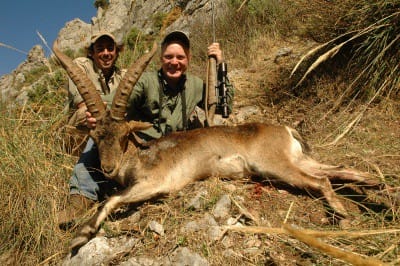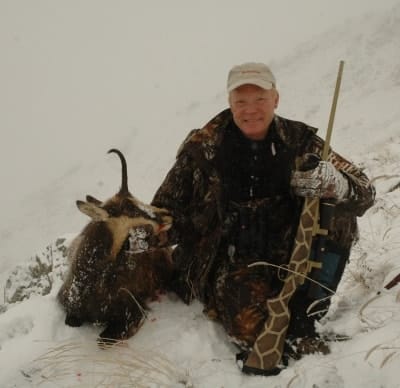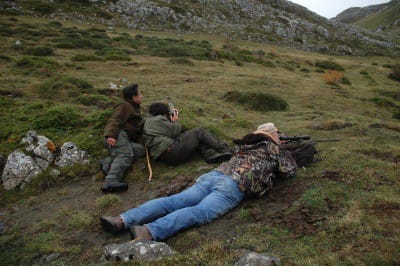 The Rocky Mountain goat ranks as one of North America’s most under-rated game animals. The wild sheep he shares much of his domain with-bighorns in the south, Dall and Stone sheep in the north-get most of the glory. I suppose this is because North America’s wild goat got cheated in the horn department, carrying short, thick, beautifully curved daggers rarely approaching a foot in length, while the wild sheep carry those gorgeous curling horns up to four times the length.
The Rocky Mountain goat ranks as one of North America’s most under-rated game animals. The wild sheep he shares much of his domain with-bighorns in the south, Dall and Stone sheep in the north-get most of the glory. I suppose this is because North America’s wild goat got cheated in the horn department, carrying short, thick, beautifully curved daggers rarely approaching a foot in length, while the wild sheep carry those gorgeous curling horns up to four times the length.
But wait a minute. It shouldn’t be just about the horns, should it? Let’s talk about the hunt. Goats are tougher than sheep, able to not just survive but thrive in country too steep, too rugged, and too austere for sheep. Much of the time goat country starts where sheep country leaves off, generally requiring more climbing in far more difficult and dangerous places. It is true that both nannies and billies grow similar horns, and that, in most situations, both sexes are legal. So just going up the mountain to shoot any goat is probably easier than hunting a ram. However, since it’s difficult to tell a nanny from a billy, and even more difficult to properly judge a good billy, the tables turn when you’re trophy hunting, and determined to take a big billy goat. A trophy male will be bigger in the body, often with a slightly yellowish cast. His horns may not be longer, but they will be thicker-and only the males have black pad-like glands at the base of the horns. But this is stuff for serious study with good spotting scopes, and not even the most experienced guides will get it right every time (which is why both males and females are legal).

With our mountain goat the long, luxurious hair is an important part of the trophy, so goat hunting is best done late in the fall, when winter coats are in-and the mountains are slick with ice and even more treacherous. A good Rocky Mountain goat, with thick black horns and flowing coat, is a fantastic trophy-to my thinking at least the equal of any ram on the mountain. The good news is that because our goats are underappreciated, goat hunts are available for a whole lot less than any sheep hunt.
Interestingly, this applies worldwide, more or less. With notable exceptions, like the fabulous (and fabulously expensive) twist-horned markhors of central Asia, most members of the goat family can be hunted for much less than any wild sheep. And while the cost may be less, the trophy may not be less imposing. The goat family varies considerably, including short-horned animals like our Rocky Mountain goat, the small and dainty hook-horned chamois, and the tahr with horns only slightly longer than our goat, but much thicker. And then there are the ibex, with fantastic, heavily ridged horns that seem to curve back forever. All of these animals offer solid hunting challenges, often up in the rocks where no sheep would tread-and many of them are available for a fraction of the cost of a sheep hunt-even in areas where they share the same mountains with sheep.
This is because the myth and mystique of sheep hunting has placed inordinate value on members of genus Ovis, the wild sheep-and much less value on genus Capra, the wild goats. For me this is a good thing. There are actually many more varieties of wild sheep in the world than wild goats. Taxonomists, keepers of hunters’ records, and hunters themselves disagree on the various races and subspecies, but by any count there are more than 40 varieties of wild sheep…and not much more than 30 of wild goat. Even so, I’ve been able to do a lot more goat hunting than sheep hunting. At this writing I’ve taken twenty-one varieties of wild goats, including seven races of chamois and eleven of ibex. Of wild sheep, just fifteen varieties. The reason for the difference is twofold: Primarily, I love mountain hunting, and I can afford most goat hunts. There are many sheep hunts that I can’t afford, and never will be able to fund. Secondarily, mountain hunting is mountain hunting, and I rate the goats (all of them, including the classy little chamois) an equal experience to any sheep hunt.

The cult of sheep hunting runs strong, and it took me some years to understand that a goat hunt wasn’t just a poor man’s sheep hunt, but was equally worthy on its own merits. For many years I wanted to hunt Mongolia, where the game includes three different varieties of the big-bodied, heavy-horned argali sheep. I well remember, thirty years ago, when one could hunt argali and ibex together for the cost of a Texas whitetail hunt today. I didn’t go then, and those days are gone. Today the Mongolian argalis start at about the cost of a fully-loaded SUV-but the smaller Gobi ibex and the big Siberian ibex can both be hunted for…about the cost of a guided deer hunt. I finally accepted that I had missed my chance, and I would probably never hunt those big argalis-but I could still hunt the rocky hills of the Gobi Desert, and the high Altai Mountains where both argali sheep and Siberian ibex roam. So I went to Mongolia, and I had wonderful mountain hunts for both varieties of ibex.
Last year I went to Pakistan, home to several varieties of sheep and goats. I hunted Blanford Urial, plus Sind ibex in the south, then went north to the tall mountains for Himalayan ibex. The permit for the Blanford Urial, smallest wild sheep in the world, was considerably more than the other two put together. Once again I bought into the cult of sheep hunting, and that was the only disappointment of the hunt. Both ibex offered better hunts, and were inestimably more impressive trophies.
By now you’d think I might have learned, and maybe I have. My most recent mountain hunt, to Spain and then on to Turkey, was for ibex and chamois, no sheep. I hope there is still some sheep hunting in my future but, realistically, I’m in my late fifties now. The time when I can still climb the mountains is dwindling. Some affordable goat hunts remain-and relatively few sheep hunts that might still be possible. So, for much of my mountain hunting, I’m a goat hunter, and not the least ashamed of it. You can call a goat hunt a poor man’s sheep hunt if you like, but I prefer to think of it a smart man’s mountain hunt.



